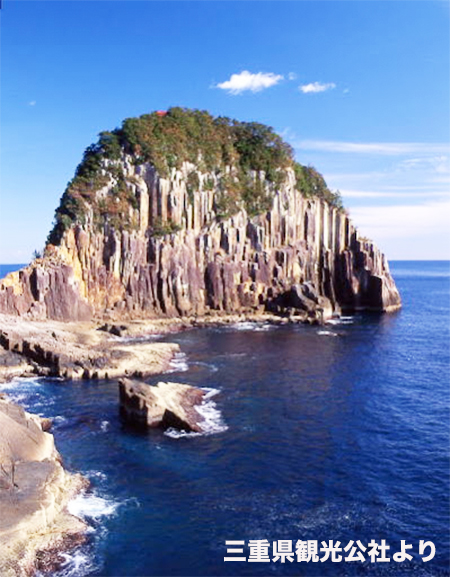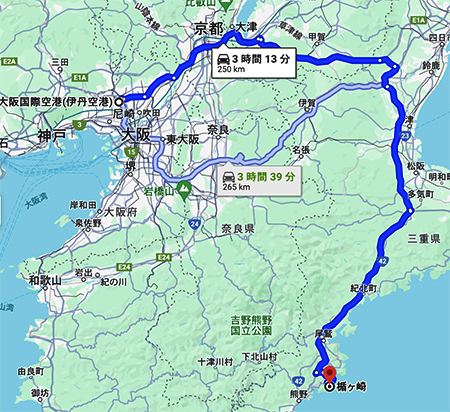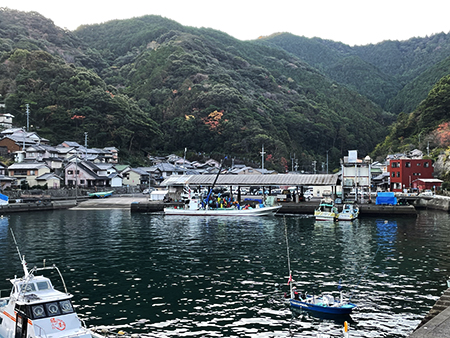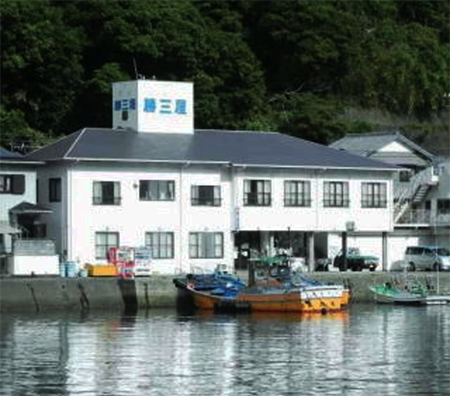

楯ヶ崎という景観の写真は上のようにWEB上で確認することができる。北海道の層雲峡などでよく見ている「柱状節理」地形がそのまま海中からそそり立っていると事前には感じられていた。
神武東征という皇統の成立にとっての歴史的結節点のことを北海道にいて考えて続けていた。一回現地を見てみたい、古代史のナゾ、日本の国の始原のカタチを構成した「国体のルーツ」を確認したいと念願したワケ。他用もあったけれど、主にこのことを眼目にして北海道を旅立った。その時間を持てるようになったことに深く感謝しながら。
日本列島37,000年史という見方では、ながく縄文的な狩猟採集の時代が続き、大きな食物採集要素として海生動物の摂取が基盤を形成していた。日本海側地域だけではなく太平洋側海岸地域でも同様に適地「開発」されていたに違いない。それが弥生以降、稲作農業が国土全域に拡大しその適不適によって開発偏差が進行したことだろう。
日本皇室の成り立ちにとって、稲作文化の主導者という側面は強かったのだと感じる。アマテラスが皇祖神であることは稲作農業の最大の守護神が太陽神であることを示しているし、天皇は農業歳事について田植えなどを行うことが知られて、繰り返し国民に広報拡散されている。
北海道がながく日本国家から化外扱いされてきたことはこうした国の成り立ちも関わっているのだろう。日本の国体が中華的権威主義国家とか、あるいはロシア的な狩猟採集型独裁国家であれば、北海道島へのこのような歴史的・伝統的な距離感はなかったのではないか。ロシア皇帝型権力であれば間違いなくすぐに領土化しただろう。
話がそれ気味(笑)。ともあれ、北海道から熊野・楯ヶ崎はとにかく遠い。
旅程の関係から大阪伊丹空港に降りて神戸空港から北海道に帰ることになった。大阪からは伊勢路を通るか、紀州路を通るか迷うけれど、高速道路の利便性などを考えて伊勢路となった。日中時間に途中にいくつかのポイントも経由して寄り道できるのでその利便性もあった。なので楯ヶ崎になるべく近い場所で夜に到着・宿泊して、元気いっぱいの状態で早朝から山道往復4kmを踏破したいと考えたのであります。あ、もちろん移動はレンタカー。


写真は宿泊した「勝三屋」さんの様子。三重県尾鷲市梶賀町ということで楯ヶ崎へ向かうには伊勢路ルートとしてはいちばん近そうだったのですね。途中数カ所寄り道した後だったので、現地到着は夜の8時ころ。着いてみて初めて、こちらが漁港に面していて「釣り人」御用達系だということを知った(笑)。
ご主人は漁師さんで釣り人をスポット箇所に送迎されたりしていて、奥さんが接客食事などをやっているという「家庭的」な雰囲気。楯ヶ崎のいちばん近い宿泊施設という当方の選択基準は、現地としては「へぇ〜」という勘違いぶりでした(笑)。まぁそういうのも旅の面白さ、ではありますね。 <長くなったので以下、あしたへ>
English version⬇
From Hokkaido to Tategasaki, the site of the Jimmu expedition to the east, a trip to Kumano and the myth of the Imperial lineage -5
Arriving in Osaka, we took the Ise route to Kumano Tategasaki. After several stops along the way, the nearest inn was reserved for sea anglers. A modern-day Kumano pilgrimage to a nearly extinct land (laugh). The first time I went to Ise…
Photos of the Tategasaki landscape can be found on the web as shown above. I had a preliminary impression that the “columnar jointed terrain” often seen in Sounkyo and other places in Hokkaido was rising directly out of the sea.
While in Hokkaido, I kept thinking about the historical node for the establishment of the imperial lineage, the Jimmu expedition. I wanted to visit the site, to see the mysteries of ancient history, and to confirm the roots of the kokutai, which constituted the original form of the nation of Japan. Although I had other plans, this was the main purpose of my trip to Hokkaido. I am deeply grateful that I now have the time to do so.
The 37,000-year history of the Japanese archipelago shows a long period of Jomon-like hunting and gathering, based on the consumption of marine animals as a major food-gathering element. Not only the Sea of Japan coast region, but also the Pacific coast region must have been “developed” in the same way. After the Yayoi period, rice agriculture expanded throughout the country, and development deviations probably progressed according to the suitability of the land.
I feel that the leadership of rice culture was a strong factor in the formation of the Japanese imperial family. The fact that Amaterasu is the ancestral deity of the emperor indicates that the sun goddess is the greatest guardian deity of rice agriculture, and the emperor is known to perform agricultural events such as rice planting, which is repeatedly publicized and spread among the people.
The fact that Hokkaido has long been treated as an outcast by the Japanese nation may have something to do with its origins. If Japan had been a Chinese-style authoritarian state or a Russian-style hunter-gatherer dictatorship, this historical and traditional distance from the island of Hokkaido would not have existed. A Russian czarist-type power would certainly have made it a territory immediately.
This is a bit off topic (laughs). Anyway, Kumano and Tategasaki are far from Hokkaido.
Due to our itinerary, we had to get off at Osaka Itami Airport and return to Hokkaido from Kobe Airport. I was torn between taking the Ise-road or the Kishu-road from Osaka, but decided to take the Ise-road considering the convenience of the expressway. We also had the convenience of being able to stop at several points along the way during the daytime. Therefore, we wanted to arrive and stay at a place as close to Tategasaki as possible at night, and start the 4-km round trip on the mountain road early in the morning with full of energy. Oh, and of course, we rented a car for transportation.
The photo shows the “Katsumiya” where we stayed. The hotel is located in Kajiga-cho, Owase City, Mie Prefecture, so it was the closest Ise route to Tategasaki. We arrived there around 8:00 p.m. after making several stops along the way. It was only after we arrived that we learned that the restaurant faced a fishing port and was frequented by “fishermen” (laugh).
The owner is a fisherman who takes anglers to and from the spot, and his wife is in charge of serving customers and making meals. Our selection criterion was that it was the closest accommodation to Tategasaki, but we were mistaken. Well, that’s the fun of traveling, isn’t it? <(Laughs.) It’s a long story, so I’ll leave it for tomorrow.
Posted on 1月 6th, 2024 by 三木 奎吾
Filed under: 日本社会・文化研究







コメントを投稿
「※誹謗中傷や、悪意のある書き込み、営利目的などのコメントを防ぐために、投稿された全てのコメントは一時的に保留されますのでご了承ください。」
You must be logged in to post a comment.